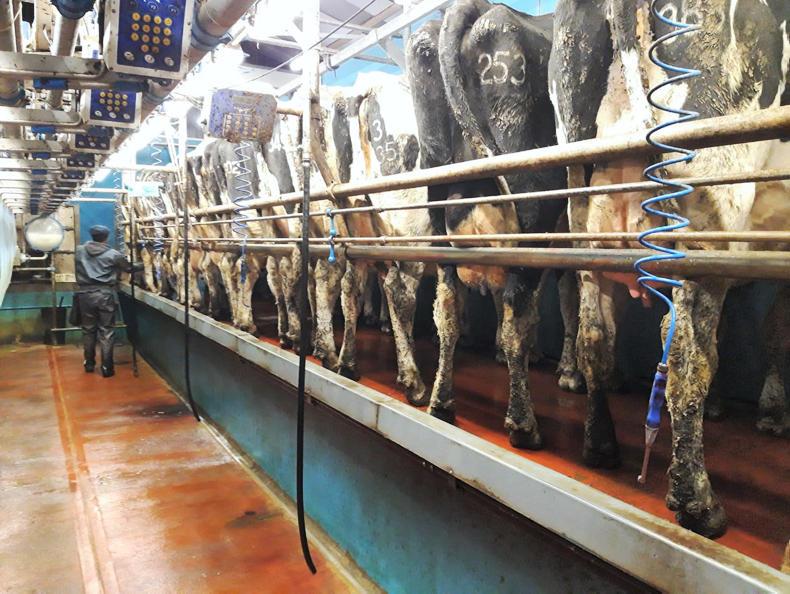My question: when is a winter bonus not really a winter bonus?
The answer – when it is used to compensate for a cut in base price that is already below the cost of production.
If you look up the definition of the word bonus in the dictionary, it says: “A sum of money added to a person’s wages as a reward for good performance.”
In my view, dairy markets are dictated by three things: supply, demand and, more importantly, sentiment
This is in contrast to the definition of necessity, (that being a decent milk price) which reads as this: “Something that you need, especially in order to live.”
I think all of the above will probably strike a chord with the many dairy farmers, who, when expecting a winter bonus to help boost the milk cheque to a better price, were shocked and disappointed to see this coupled with a cut in October base price.
In my view, dairy markets are dictated by three things: supply, demand and, more importantly, sentiment.
I’m sure we are all aware that there is a lag between what markets are returning and when this feeds through to our milk price. On the other hand, few could argue about recent sentiment, which indicates that markets are turning and prices should be rising in the new year.
With that in mind, surely there was no excuse to cut price at this costly time? We will all need to keep pressure on processors to step up to the mark in the new year, especially when the so-called winter bonus drops off the price for January produced milk.
Rising costs
Only this week, I was looking back at this year’s base price compared to last year. There is 2.75p of a difference. When you factor in the rise in costs, the actual difference in real terms is probably closer to 4p.
I then had a look back further to November 2017 and nearly fell off my chair at a base price of 29.25p.
It sometimes looks like the new entrants are being used to compensate for the farmers who are ready to quit
Perhaps instead of throwing money at new entrants, would it not be more sensible for processors to support those of us who are in milk and committed to it? Some of these new entrants may not have as bright a future milking cows as they think, once the incentives drop off. It sometimes looks like the new entrants are being used to compensate for the farmers who are ready to quit due to a lack of profitability.
Production
Lack of profit aside, so far this winter cows are going well on the farm with production at 31.6l, and 4.35% butterfat and 3.42% protein (2.52kg solids/cow) from a feed rate of 0.37kg per litre.
Breeding is well under way – we are three weeks in, and the next week will be an indication as to how things are going depending on the number of repeats. So far, most cows have been served with sexed semen, and the rest with beef.
It takes a certain degree of confidence to pursue this policy. When a cow comes in heat, I check her milk solids on the phone and then make the decision whether it is a dairy or beef sire.
I find myself thinking sometimes that it is a shame to serve a cow like that with a beef bull
In some cases, a cow has low solids, but is a really fertile good breeder. Which is more important?
There is another question – what should I do when there are multiple generations of good type, but poor solids?
I find myself thinking sometimes that it is a shame to serve a cow like that with a beef bull. On the other hand, if we keep doing what we’ve always done, how do we make any progress?
Read more
Farmer Writes: higher quality silage proves its worth
Watch: sexed semen brings lots of heifer calves
My question: when is a winter bonus not really a winter bonus?
The answer – when it is used to compensate for a cut in base price that is already below the cost of production.
If you look up the definition of the word bonus in the dictionary, it says: “A sum of money added to a person’s wages as a reward for good performance.”
In my view, dairy markets are dictated by three things: supply, demand and, more importantly, sentiment
This is in contrast to the definition of necessity, (that being a decent milk price) which reads as this: “Something that you need, especially in order to live.”
I think all of the above will probably strike a chord with the many dairy farmers, who, when expecting a winter bonus to help boost the milk cheque to a better price, were shocked and disappointed to see this coupled with a cut in October base price.
In my view, dairy markets are dictated by three things: supply, demand and, more importantly, sentiment.
I’m sure we are all aware that there is a lag between what markets are returning and when this feeds through to our milk price. On the other hand, few could argue about recent sentiment, which indicates that markets are turning and prices should be rising in the new year.
With that in mind, surely there was no excuse to cut price at this costly time? We will all need to keep pressure on processors to step up to the mark in the new year, especially when the so-called winter bonus drops off the price for January produced milk.
Rising costs
Only this week, I was looking back at this year’s base price compared to last year. There is 2.75p of a difference. When you factor in the rise in costs, the actual difference in real terms is probably closer to 4p.
I then had a look back further to November 2017 and nearly fell off my chair at a base price of 29.25p.
It sometimes looks like the new entrants are being used to compensate for the farmers who are ready to quit
Perhaps instead of throwing money at new entrants, would it not be more sensible for processors to support those of us who are in milk and committed to it? Some of these new entrants may not have as bright a future milking cows as they think, once the incentives drop off. It sometimes looks like the new entrants are being used to compensate for the farmers who are ready to quit due to a lack of profitability.
Production
Lack of profit aside, so far this winter cows are going well on the farm with production at 31.6l, and 4.35% butterfat and 3.42% protein (2.52kg solids/cow) from a feed rate of 0.37kg per litre.
Breeding is well under way – we are three weeks in, and the next week will be an indication as to how things are going depending on the number of repeats. So far, most cows have been served with sexed semen, and the rest with beef.
It takes a certain degree of confidence to pursue this policy. When a cow comes in heat, I check her milk solids on the phone and then make the decision whether it is a dairy or beef sire.
I find myself thinking sometimes that it is a shame to serve a cow like that with a beef bull
In some cases, a cow has low solids, but is a really fertile good breeder. Which is more important?
There is another question – what should I do when there are multiple generations of good type, but poor solids?
I find myself thinking sometimes that it is a shame to serve a cow like that with a beef bull. On the other hand, if we keep doing what we’ve always done, how do we make any progress?
Read more
Farmer Writes: higher quality silage proves its worth
Watch: sexed semen brings lots of heifer calves






 This is a subscriber-only article
This is a subscriber-only article










SHARING OPTIONS: